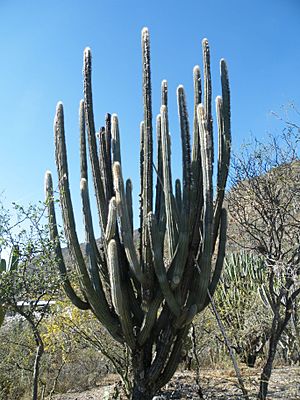Pilosocereus chrysacanthus facts for kids
Quick facts for kids Pilosocereus chrysacanthus |
|
|---|---|
 |
|
| Scientific classification |
Pilosocereus chrysacanthus is a fascinating type of cactus. It is known for its tall, column-like shape. This plant belongs to the Pilosocereus group of cacti. You can find it growing naturally in parts of Mexico and Central America. Its natural home stretches all the way to Honduras.
Contents
Discovering the Pilosocereus Chrysacanthus Cactus
This unique cactus is often called the "golden-spined cereus." This name comes from its striking appearance. It has many spines that can look golden or yellowish. These spines cover its ribbed stems. The plant can grow quite tall, reaching several meters high.
Where Does This Cactus Live?
Pilosocereus chrysacanthus thrives in warm, dry places. Its native habitat includes dry forests and scrublands. It is well-adapted to areas with little rainfall. This cactus is found in specific regions of Mexico. It also grows in countries like Guatemala and Honduras. These areas have the perfect climate for it to grow.
What Does It Look Like?
The stems of Pilosocereus chrysacanthus are usually blue-green. They grow upright, like pillars. These stems have several ribs running along them. The ribs are where the spines grow from. The spines are a key feature of this cactus. They are often bright yellow or golden. This gives the plant its special name.
Flowers and Fruits
Like many cacti, Pilosocereus chrysacanthus produces flowers. These flowers usually bloom at night. They are often white or pale in color. After the flowers are pollinated, they turn into fruits. The fruits are typically small and round. They contain tiny seeds inside. These seeds help the cactus reproduce.
Life Cycle of the Pilosocereus Cactus
The life cycle of Pilosocereus chrysacanthus starts from a tiny seed. If the seed lands in a good spot, it will sprout. It needs enough warmth and a little moisture to begin growing.
How It Grows
Young cacti grow slowly at first. They develop strong roots to anchor them. The roots also help them find water deep in the soil. As they get older, the stems grow taller. They become thick and woody at the base. This helps the tall cactus stand firm.
Reproduction
Pilosocereus chrysacanthus reproduces mainly through its seeds. Flowers are pollinated by animals like bats or moths. These animals are active at night. They visit the night-blooming flowers. The fruits then develop from these flowers. When the fruits ripen, they release their seeds. These seeds can then grow into new plants.
Spreading Seeds
Animals often eat the fruits of the cactus. The seeds pass through their digestive system unharmed. They are then dropped in new locations. This helps the cactus spread its population. Sometimes, parts of the stem can break off. If these pieces land on suitable soil, they might also grow roots. This is another way the plant can spread.
Importance of Pilosocereus Chrysacanthus
This cactus plays a role in its ecosystem. It provides food and shelter for various animals. Its flowers are a food source for nocturnal pollinators. The fruits are eaten by birds and other creatures.
Protecting This Cactus
Like many plants, Pilosocereus chrysacanthus faces challenges. Habitat loss is a big concern. This happens when its natural home is cleared for farming or building. Protecting these areas helps ensure the cactus can continue to thrive. Conservation efforts aim to keep its populations healthy.
See also
 In Spanish: Pilosocereus chrysacanthus para niños
In Spanish: Pilosocereus chrysacanthus para niños

